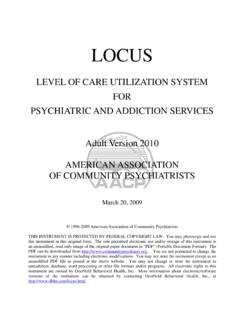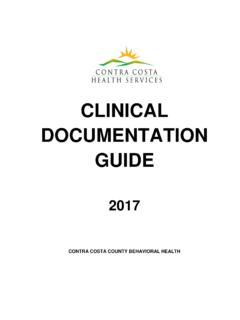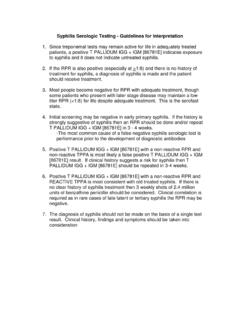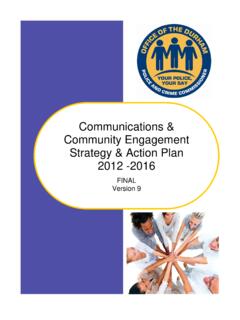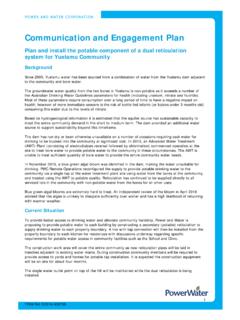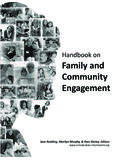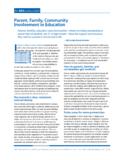Transcription of Community Engagement in Public Health
1 Community Engagement in Public Health Abstract Local Public Health departments are charged with promoting overall Community Health and well-being and addressing the causes of disease and To achieve these goals in the 21st century, local Health departments need to engage diverse communities in developing a broad spectrum of solutions to today's most pressing problems, including chronic diseases (the leading causes of death), Health disparities, and other complex Community Health Drawing from a decade of experience in a relatively large local Health department in California, this paper introduces a a conceptual framework for Community Engagement in Public Health . It presents the Ladder of Community Participation as a way to illustrate a range of approaches that can be used to engage communities around both traditional and emerging Public Health issues.
2 This paper highlights real life examples of Contra Costa Health Services' Community Engagement practices. Based on the lessons learned, it offers suggestions to help other local Health departments enhance their own activities. AUTHORS: Introduction Mary Anne Morgan, The Public Health issues of the 21st century include chronic diseases (such as cancer, obesity and MPH, is the Director of Public diabetes), gun violence, and homelessness, as well as communicable disease and maternal and child Health Outreach, Health . These problems affect low-income and minority populations disproportionately and are Education and influenced by the physical, social and economic environments in which people live. Collaboration. To address these complex Health issues effectively, modern local Health departments (LHDs) must Jennifer Lifshay, MBA, broaden their approaches and use a spectrum of strategies to build Community capacity and promote MPH, is an Evaluator/.
3 Planner in the Community Community , 4 Respected Public Health organizations around the world, including the World Health Assessment, Health Organization, recognize the importance of including Community Engagement in this spectrum Planning, and Evaluation of The Centers for Disease Control and Prevention's (CDC) Ten Essential Services for Group, Contra Costa Public Health outlines the core Public Health activities including two Community Engagement -related Health Services. essential Public Health functions: Inform, educate and empower people about Health issues and Mobilize Community partnerships and actions to identify and solve Health problems. 6 To carry This article was produced out these functions and address the Public Health disparities of today, local Health departments must with partial funding expand their ability to engage , 8.
4 From The California Endowment. The authors acknowledge the contribu- tions of the CCHS Writers Group and its Community and organizational partners. Public Health Division 597 Center Avenue Martinez, CA 94553. What is Community Engagement ? and perspectives needed to identify and define issues and to Community Engagement involves dynamic relationships craft viable 10 11 Even when addressing newer issues and dialogue between Community members and local Health such as bioterrorism planning, where the Health department is department staff, with varying degrees of Community and the lead, sharing ownership of the agenda with communities Health department involvement, decision-making and control. has been shown to be critical to developing trust and creating plans that incorporate local In Public Health , Community Engagement refers to efforts that promote a mutual exchange of information, ideas and Contra Costa's Experience resources between Community members and the Health Contra Costa Health Services (CCHS) has a long history of department.
5 While the Health department shares its Health developing strategies for engaging communities to promote the expertise, services and other resources with the Community Public 's 14 15 16 More than 20 years ago, CCHS formed through this process, the Community can share its own wisdom a coalition of heart, lung and cancer agencies and engaged the and experiences to help guide Public Health program efforts. local medical Community to enact the nation's first uniform, Community may include individuals, groups, organizations, countywide legislation restricting tobacco use in Public areas and associations or informal networks that share common in the work place in all 19 cities in Contra Costa County. characteristics and interests based on place-, issue-, or identity- In 1987, CCHS established a Public and Environmental based factors.
6 These communities often have similar concerns, Health Advisory Board, a citizen group to advise the Health which can be shared with the Health department to help create Department and County Board of Supervisors on Community more relevant and effective Health programs. concerns and emerging Public Health issues. In the 1990s, CCHS expanded the coalition strategy to address Public Health A Historical Perspective issues ranging from childhood injury and breast cancer to gun Community Engagement is not a new strategy in Public violence and homelessness. During this time period, CCHS. Health . It has played an important role in the field over the launched the Healthy Neighborhoods Project (HNP), which last century, originating in traditional Public Health practice and uses a Community leadership development strategy to stimulate evolving in response to changing population Health issues and involvement of low-income, ethnically diverse communities in the need to develop additional strategies to address them.
7 Identifying and collectively addressing their own Community Health priorities. These Community partnership and In the early 20th century, Public Health experts took the lead Engagement approaches have been institutionalized in CCHS. in determining the priority Health issues and solutions. At that through the creation of two specific Public Health units, the time, Public Health used Community Engagement strategies Community Wellness and Prevention Program (CW&PP). primarily to control communicable diseases by mobilizing and Public Health Outreach, Education and Collaborations people to participate in mass immunization, sanitation and (PHOEC). hygiene programs. This paper shares the results of our efforts to document When chronic diseases emerged as the leading causes of and understand CCHS' efforts in Community Engagement .
8 Death in the 1950s, Public Health recognized that social and In 2004, PHOEC organized workshops on Community environmental factors strongly influenced the development of participation strategies for Public Health staff and conducted these conditions. Local Health departments started to involve in-depth interviews and surveys with Advisory Boards' leaders Community stakeholders in developing broader solutions and program managers to identify their most promising to address both behavioral and environmental risk factors Community Engagement practices. We describe some of associated with these diseases. The passage of California's these practices here. Drawing on the lessons learned, we offer Proposition 99 Tobacco Tax in 1988 provided funding for suggestions to guide local Health departments in their efforts to Health departments to go further in their efforts, forming develop their own Community Engagement strategies.
9 Coalitions and mobilizing communities to organize and advocate for policies to prevent tobacco use. These activities Like most other local Health departments, Contra Costa led to environmental and Public Health protective policies, has had limited ability to document and demonstrate a changed Community and social norms about smoking, and direct link between Community Engagement practices and decreased smoking rates across the country. improvements in population Health outcomes. Health departments often lack the staff resources and the necessary Increasingly, LHDs have engaged diverse communities in data to evaluate these kinds of long-term impacts, which can helping to set the local Public Health agenda and collectively take many years to achieve. For this reason, this article focuses determine appropriate interventions.
10 Reducing the Health on more intermediate results of Community Engagement disparities of the 21st century will require even greater work by describing changes to the climate within the Health Community participation to harness the diverse skills, resources department, the service delivery system, and in organizational or Public policies that impact the Community environment. 2. A Framework: Ladder of Community Participation Based on our experiences, CCHS adapted the Ladder of Community Participation17 as a tool for local Health departments to use when thinking about how to build on their existing efforts to engage communities in Public Health . The Ladder describes a continuum of approaches that are used even in the most traditional Public Health areas, such as environmental Health and emergency response.
